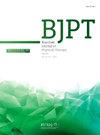用于评估心力衰竭和射血分数降低患者功能能力的 Glittre-ADL 测试:再现性、最小检测变化和临界点。
IF 3.2
3区 医学
Q1 ORTHOPEDICS
引用次数: 0
摘要
背景:心肺运动测试(CPET)是功能能力评估的黄金标准,但成本高昂且不易获得。对于心衰患者来说,Glittre-ADL 测试可能是一种低成本的替代方法:目的:使用 Glittre-ADL 测试确定心衰患者功能能力的临界点。我们还评估了一致性、可靠性和最小可检测变化:这项横断面研究的对象是 78 名射血分数降低的心衰患者(年龄在 21 岁至 65 岁之间)(纽约心脏协会功能分级 II 级和 III 级)。使用类内相关系数(ICC)测量重测可靠性,同时使用接收器操作特征曲线(ROC)确定 ADL-时间是否能区分峰值耗氧量(VO2peak)< 16 和≥ 16 ml/kg/min 的患者:根据 Glittre-ADL 测试所花费的总时间,确定了 255 秒的分界点(灵敏度为 76% [95 % CI 58, 89] ,特异度为 72% [95 % CI 56, 85]);曲线下面积为 0.773 (95 % CI 0.663, 0.861; p < 0.0001)。在一致性方面,测试和复测之间存在明显的相关性(r = 0.83,r2 = 0.69,p < 0.001)。类内相关系数、绝对可靠性和最小检测变化分别为 0.84 (95 % CI 0.45, 0.94; p < 0.001)、3.2 % 和 8.8 % (23.1 s):Glittre-ADL测试在重复测试中表现出良好的重现性。结论:Glittre-ADL测试在重复测试中显示出良好的重现性,因此,我们的研究确定的临界点可在临床实践中代替CPET用于识别严重心力衰竭患者。本文章由计算机程序翻译,如有差异,请以英文原文为准。
Glittre-ADL test to assess functional capacity in patients with heart failure and reduced ejection fraction: Reproducibility, minimal detectable change, and cutoff point
Background
Cardiopulmonary exercise testing (CPET) is the gold standard for functional capacity assessment, although it is costly and not easily accessible. The Glittre-ADL test may be a low-cost alternative for patients with heart failure.
Objective
To establish a cutoff point for functional capacity of patients with heart failure using the Glittre-ADL test. We also assessed agreement, reliability, and minimal detectable change.
Methods
This cross-sectional study was conducted with 78 patients (aged 21 to 65 years) with heart failure and reduced ejection fraction (functional classes II and III of the New York Heart Association). Test-retest reliability was measured using the intraclass correlation coefficient (ICC), while receiver operating characteristic (ROC) curves were used to determine whether ADL-time, could distinguish between patients with peak oxygen consumption (VO2peak) < 16 versus those ≥ 16 ml/kg/min.
Results
A cutoff point of 255 s (76 % sensitivity [95 % CI 58, 89] and 72 % specificity [95 % CI 56, 85]) was established based on the total time spent on Glittre-ADL test; the area under the curve was 0.773 (95 % CI 0.663, 0.861; p < 0.0001). Regarding agreement, a significant correlation was found between test and retest (r = 0.83, r2 = 0.69, p < 0.001). Intraclass correlation coefficient, absolute reliability, and minimal detectable change were 0.84 (95 % CI 0.45, 0.94; p < 0.001), 3.2 %, and 8.8 % (23.1 s), respectively.
Conclusion
Glittre-ADL test showed good reproducibility in repeated tests. Thus, the cutoff point established by our study can be used in clinical practice instead of CPET to identify patients with severe heart failure.
求助全文
通过发布文献求助,成功后即可免费获取论文全文。
去求助
来源期刊
CiteScore
6.10
自引率
8.80%
发文量
53
审稿时长
74 days
期刊介绍:
The Brazilian Journal of Physical Therapy (BJPT) is the official publication of the Brazilian Society of Physical Therapy Research and Graduate Studies (ABRAPG-Ft). It publishes original research articles on topics related to the areas of physical therapy and rehabilitation sciences, including clinical, basic or applied studies on the assessment, prevention, and treatment of movement disorders.

 求助内容:
求助内容: 应助结果提醒方式:
应助结果提醒方式:


